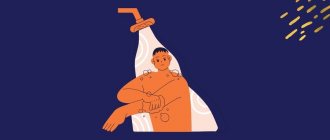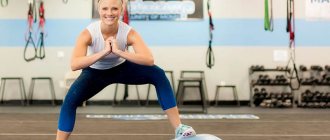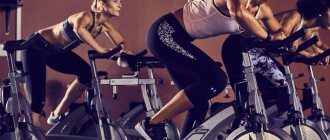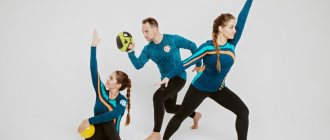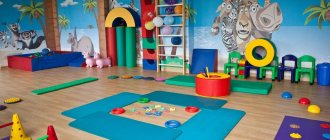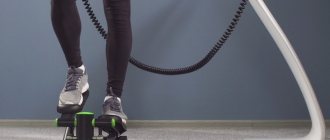If you want to minimize the harm from a sedentary lifestyle, get rid of back pain and feel free and relaxed, then stretch your entire body at least once a week.
We offer you a universal set of exercises for stretching all muscle groups, which is suitable for both beginners and experienced practitioners.
What does stretching mean?
Exercises of the stretching system were developed in the 50s of the last century in Sweden and were intended to warm up athletes before general training. The word stretch is translated from English as “stretch”, “pulling”, and it was on this principle that a new set of classes was based.
The most famous muscle stretching exercise is the splits. But the set of exercises affects not only the legs; during classes, almost all the muscles of the body are worked out. In addition, there are special exercises that improve the stretching of deep muscle layers and increase the plasticity of joints.
Stretching is an effective way to improve blood circulation, which has a positive effect on the functioning of internal organs, relieves congestion and ultimately prevents the development of somatic diseases.
Stretching exercises can be performed either independently or in combination with other procedures. Stretching is often included in the comprehensive training of professional athletes and is used in anti-cellulite programs and for weight loss.
The exercises are based on muscle tension, alternating with their relaxation. Changing the intensity of the load, working out individual zones and performing different exercises can increase the elasticity of almost all muscle groups.
Stretching can be used as a tool for body shaping. Regular exercise removes excess fat, improves relief, and tightens the hips and buttocks. As a result, within six months the body becomes slimmer.
Flexibility exercises also increase the overall tone of the body, normalize the state of the nervous system, and serve as a prevention of cardiovascular diseases, injuries and diseases of the musculoskeletal system.
Who is it suitable for?
Static traction is suitable for everyone, with the exception of people who have recently suffered musculoskeletal injuries. Otherwise, with proper and concentrated exercises, such stretching is useful for:
- The need to increase mobility and flexibility of the entire body.
- Gaining muscle mass to relax stiff areas of the body and increase amplitude in strength exercises.
- Increasing strength indicators.
- Overtraining as a recovery load.
The difference between stretching and other fitness systems
Stretching as a training system has certain differences, the main ones:
- Smoothness of the movements performed - if all rules of exercise are observed, injury is excluded;
- For training, you only need a sports mat, no additional exercise equipment is needed;
- There are no restrictions on the level of physical fitness and age;
- During exercise, not only the muscles are exposed, but the entire body as a whole, including the ligamentous-articular apparatus.
Stretching is becoming one of the most favorite types of fitness for many people. The exercises can be performed in the gym and at home, which allows you to find free time for exercise on any day.
Hamstring stretch
Leg bend exercise
Sit on the floor, stretch your legs. Bend over to your feet as low as possible.
One leg bend exercise
Similar to the previous one, only one leg needs to be bent at the knee and placed so that the foot is adjacent to the inner thigh of the other leg. Do an exercise on each leg.
Effect of exercise
Stretch exercises provide immediate effects on the muscular-ligamentous apparatus and the entire body, that is, they appear either immediately during the workout or upon its completion:
- Stretching causes reactions in the body similar to those that occur during massage and performing exercises aimed at dynamics. This leads to an increase in local temperature in the muscle area and to general warming of the body, to activation of the cardiovascular and respiratory systems;
- Biochemical reactions and metabolic processes in the worked ligaments and muscles are enhanced. This effect is well suited for warming up before main workouts and is used in the treatment of diseases of the muscular-ligamentous system and injuries;
- Improving flexibility normalizes the synthesis of proteins and DNA in tissues, activates the capabilities inherent at the genetic level, which ultimately helps to increase muscle fibers in length, stimulates the processes of regeneration and tissue renewal;
- The appearance of pain during exercise indicates the breakdown of fat cells;
- Consistent relaxation and tension of muscles has a positive effect on the functioning of the nervous system, increasing the body's resistance to psycho-emotional stress.
Stretch exercises should be performed regularly; the severity of the overall effects of training on the body depends on this.
Inner thigh stretch
Deep squat exercise
Squat down next to a support. Grab it with your hands. Feet shoulder-width apart, toes and knees turned outward. Keep your back straight.
Exercise frog
Lie on your stomach, bend your knees and spread your legs out to the sides so that they are bent at a 90-degree angle. Pull your pelvis down.
Kinds
Stretching is classified according to two parameters - the degree of load performed and the method of performing the selected exercises.
According to the degree of load, stretch exercises are divided into:
- ON SOFT. Muscles stretch during exercise only to their physiological length. Each exercise takes 30-40 seconds;
- DEEP. A whole set of exercises is performed, the purpose of which is to stretch the muscle fibers to an unusual length. The duration of each exercise is 1-5 minutes.
According to the method of execution, stretching is divided into:
- STATIC. The exercise consists of slow and smooth movements. By straining a certain group of muscles, the training person briefly hangs in this position, that is, the muscles are in a contracted form and receive a static load. Static exercises help stretch and strengthen muscles; it is recommended to start training with them;
- DYNAMIC. A set of exercises is selected, during which the muscles first tense and then relax;
- BALLISTIC. It is based on swinging exercises for the limbs, performed with increasing amplitude and speed. This helps to quickly stretch the muscles of a certain part of the body. Ballistic stretch exercises should be performed after special training, since beginners often get injured when performing them;
- SLOW. Exercises are performed at the slowest pace possible. Allows you to stretch muscle fibers and is used as a warm-up option before performing a strenuous workout;
- PAIRS. A partner helps stretch those muscle groups that are difficult to work without outside help.
There is another type of stretching – proprioceptive neuromuscular. Its main goal is to restore the functionality of joints and muscles after surgery or injury. It is carried out under the supervision of rehabilitation specialists and allows you to correct disorders caused by incorrect posture and damage to the musculoskeletal system.
Nuances and specifics
There are several types of stretching, so it’s easy to choose the one that’s right for you, depending on your preferences and complexity.
Strength gymnastics – exercises for stretching and strength of muscles. Such classes are perfect for those who have dealt with systematic stretching.
Aerostretching is a stretching and elasticity exercise using fabrics in the air. The exercises are not suitable for beginners as there is a high risk of damage and injury. This type of stretching is suitable for those who already have basic training after practicing a classic form of aerobics.
Beginners should be careful and work gradually. It is unacceptable to demand maximum results from the body in a short period of time, since heavy loads can greatly harm the muscles of the body. Beginners, as a rule, begin their work with simple exercises, holding each of them for no more than 15-20 seconds.
Basic rules for beginners:
- Proper breathing. You cannot hold or speed up your inhalations or exhalations. Throughout the entire complex you need to breathe rhythmically and measuredly. You can breathe deeply during the break between stands;
- stretching workouts are practiced after aerobics, gymnastics, and physical activity. This is what ensures the required blood flow to the muscle mass and increases their elasticity;
- after exercise, you need to relax your muscles, do not take on heavy work, avoid strength exercises, since you can overstrain the body;
- Stretching of the body occurs to a certain point - pain impulses are an indicator of a sufficient degree of load. The appearance of pain indicates that a person has reached his maximum limit of muscle stretching.
Minor pain should not be scary. There is a concept of “pleasant” pain impulses in the muscles, and “dangerous” symptoms that indicate the risk of injury or its presence. A person quickly learns to distinguish one from another after he begins training.
Basic principles of stretching
The main principle of stretching is overstretching. During training, muscles throughout the body are stretched, flexibility and plasticity of large joints increase.
These exercises help:
- Improve muscle tone and plasticity;
- Normalize weight;
- Gets rid of cellulite deposits;
- Do the splits;
- Make joints mobile;
- Slow down the aging process of the body.
After training, a surge of strength appears, you feel extraordinary vigor, tension is relieved, and all these effects persist almost throughout the day.
To maximize flexibility, daily intensive sets of stretch exercises are necessary; they allow, due to the cumulative effect, to maintain the achieved level of muscle stretching.
In the future, to maintain the developed stretching, it is enough to devote one to two days a week to stretching.
Recommendations
- Beginners should perform each exercise for 30 seconds. If discomfort is present, this time can be shortened or the degree of muscle tension reduced.
- More advanced people should perform the exercises for 1-3 minutes, depending on the sensations and the desired result.
You should not train more than three times a week. The duration of one lesson should not exceed one hour. And for those who do strength training, this complex is perfect as a cool-down at the end of a workout. Of course, the position holding time should be reduced.
And also read: Pilates for a flat stomach: the “Big Five” complex → Why can’t you stretch cold muscles? Is it possible to stretch every day?
Benefit
Stretching exercises have gained popularity not only due to the ease of their implementation and the possibility of training at any age. Regular exercises contribute to:
- While working out almost all muscle groups of the body, regular fitness does not give this result;
- Removing nerve and muscle blocks in all parts of the body, which reduces pain. Many women note a decrease in pain during menstrual periods when doing exercises;
- Activation of the work of peripheral vessels, due to this, congestion is eliminated, and, accordingly, the development of such dangerous pathologies as thrombosis and atherosclerosis is prevented;
- Reduce salt deposits. Stretching is one of the most effective ways to prevent hypokinesia and osteoporosis;
- Straightening posture, correcting figure volumes;
- Increasing self-esteem, relieving mental stress;
- General rejuvenation of the body.
Stretch exercises can be performed at any time of the day. They can be done during cardio training and strength training. The first results of the classes become clearly noticeable within a month - without problems or difficulties, people sit in the lotus position, bend without tension, and become more resilient.
Indications for exercises
Physical inactivity, as a particular manifestation of it, is sedentary work. Being without movement for a long time, when the position does not change, the muscles become hard and petrified. Because of this, the vessels located around are compressed and the nerve endings are compressed. Blood circulates poorly and stagnates. The body warms up unevenly, feeling either hot or cold. Regular discomfort provokes diseases, one of which is osteochondrosis.
Physical activity, regardless of its origin. Either these are household chores that you decided to do in one day, or training in the gym. This should also include:
- long walks on foot;
- carrying heavy objects (heavy bag from the market);
- standing at the stove for a long time, etc.
Someone may say that they feel great after a tiring day of work or active training. Does not experience tension in the lower back, shoulders, or shoulder blades. Despite this, it is worth performing back and spine stretching exercises for beginners as a preventative measure to maintain joint flexibility.
But if you are in pain, you find it difficult to:
- going down or going up stairs;
- enter the steep steps of public transport;
- tie shoelaces;
- straightening up at the end of the day means that your back requires close attention and a caring attitude.
In addition to the listed indications, it is worth doing exercises to stretch the spine at home, not only as a means of recovery after exercise, but in preparation for them. When you know that a difficult day is ahead, you will have to spend a lot of time without squatting, prepare your body for difficulties - do a little exercise, then you will feel how much easier the day's work is perceived.
Contraindications
Stretching is contraindicated:
- During the recovery period after injuries and severe diseases of the spine;
- For fractures;
- During the period of exacerbation of inflammatory and degenerative diseases of muscles, tendons and ligaments;
- People with severe varicose veins;
- People with decompensated stages of pathologies of the cardiovascular system.
Stretching can also be used as physical therapy, but in this case, sets of exercises should be selected only by a doctor and carried out under the guidance of an experienced specialist.
Chest stretching
Doorway Exercise
The exercise speaks for itself - lean on the doorframes of the passage with your elbows, move your body forward, thereby stretching the chest muscles.
Wall exercise
Place your hand on the wall, lower your shoulder and turn in the opposite direction. Repeat the same with the other hand.
The danger of stretching
Muscle stretching must be performed in compliance with certain rules, and it is better if the first lessons for beginners are conducted by a specialist who is professionally involved in stretching. Improper stretching can cause serious injury.
Particularly dangerous:
- Improper execution of stretch exercises for the neck muscles. You can’t lift your head too high or sharply when stretching back. This can result in pinched nerves, dizziness and vascular disorders;
- These exercises are aimed at overstretching the muscle groups of the back and lower extremities. Classic pose - sitting on the floor, from this position stretch with straightened arms to the toes. A common mistake is stretching the head; when performing this exercise, one should reach for the feet with the chest, this will allow the tension to be distributed as correctly as possible from the back to the muscles of the hip joint and lower extremities;
- Hyperextension of the legs, in which one of the joints assumes an abnormally incorrect position.
Stretching involves stretching muscle fibers, but this does not mean that you should try too hard. If the training technique is not followed, the resulting injuries will permanently limit the choice of not only sports, but also ordinary loads.
Front Thigh Stretch
Lying quadriceps exercise
Lie on your stomach, lift your right leg from the floor, bending the knee and clasping the foot with your hands from behind. Pull your leg towards your buttock, trying not to lift your leg off the floor. Repeat the same with the other leg.
25. Lunges
Lunge forward, while holding your front knee with your hands. Place your straightened leg on the floor. Repeat on the other leg.
General rules for performing stretch fitness
- The body must be stretched only to a certain limit; the appearance of pain must be perceived as reaching the maximum in overstretching of the muscle fibers. There should not be any severe pain;
- Before stretch exercises, you should do a comprehensive warm-up for the whole body, this ensures a rush of blood to the muscles and increases elasticity;
- You need to monitor your breathing, it should be smooth, rhythmic, there is no need to emphasize inhalation and exhalation. Exhale when bending, inhale air while stretching. It is recommended to breathe deeply while changing positions;
- Each pose taken is held for 10-30 seconds;
- During exercise, you must maintain a stable position.
After stretching, the muscle fibers should be in a relaxed state, so strength training should not be performed.
Advantages and disadvantages
- The advantages include the fact that static stretching eliminates rocking, springing movements and constant alternation of stretching with relaxation, as in the dynamic version. Holding a static position is the safest, since sensations can be controlled and do not subject the fibers to additional stress. After stretching, the muscles should be given rest for the same time as during the exercise.
- Also, static traction effectively relaxes muscles, reducing their tightness, hypertonicity, pain, and also increases the range of motion of joints.
The disadvantages include the risk of fiber injury, which is present with any type of stretching. Intense and painful traction can injure tissue, and some exercises may have a higher potential for muscle damage, such as splits.
Cloth
You should exercise both at home and in the gym in specially selected clothes. It should be made of durable and at the same time elastic materials. The trainee should not feel that the clothes are tight, pressing, or making it difficult to move.
It is best to purchase a suitable suit at specialized sales points, where sales consultants can select shorts, leggings, tops, T-shirts, based on the type of expected load, size, and comfort.
Stretching and pregnancy
Stretching is not prohibited for pregnant girls if several conditions are met:
- The expectant mother’s well-being does not suffer, there are no complications or risks;
- All movements are carried out smoothly and carefully;
- A set of classes is conducted under the supervision of a professional instructor;
- Bends from a standing position are excluded from training. Pregnant women should bend over when stretching muscles only in a sitting position.
Stretching for pregnant women is an ideal option for preparing the body for bearing a baby and for childbirth. Regular exercise improves muscle elasticity, allows you to maintain body weight within normal limits, normalizes mood, and prevents muscle cramps.
Stretching is contraindicated for pregnant women if:
- Threat of premature birth or early miscarriage;
- Placenta previa;
- Hypertension;
- Weakness of the cervix.
You should temporarily stop exercising if you experience nagging pain in the lower abdomen and spotting.
Basic set of exercises
Stretch exercises are selected based on age and general level of physical fitness. Beginners can use a universal set of classes:
- STRETCHING. For the muscles of the back, shoulders and arms from a vertical position. While standing, you need to pull both arms up alternately. The correct performance of the exercises is indicated by a feeling of moderate tension in the muscles; PHOTO 8
- WORKING THE NECK MUSCULATES. Place your right hand on your waist, your left palm on your head, and gently tilt your head to the left. Do 10 approaches on each side, resting for a few seconds between stretches;
- WORKING ALL MUSCLE GROUPS. Lean on your bent left knee, move your right leg bent at the knee forward. Extend your right arm up and slowly, smoothly lean back. The exercise is performed on each side 5-6 times;
- TRAINING THE MUSCULAR CORSET OF THE BACK AND LEGS. Press your hands and back tightly against the vertical wall, slowly lower down, the spine should remain straight. It is recommended to do up to 6-7 squats;
- WORKING THE MUSCULARITY OF THE NECK AND SPINE. Sit on a chair, cross your legs and lean them on the floor. Place your palms and press your chin to them. Strain your neck and arms, you need to withstand the effort for half a minute. You need to do 8 repetitions, relaxing between them for 20 seconds;
- PRESS AND BACK TRAINING. Sitting on the floor, spread your legs wide, place the palms of your hands on the back of your head. Slowly, with a round back, bend towards your knees, alternately for 8 repetitions;
- GENERAL STRETCHING. Position – standing on all fours, at the same time you need to pull your right leg back and the opposite hand forward. Movements should be smooth but slow. You need to do 7-8 stretches.
There are many other exercises.
Shoulder stretch
Exercise for the front of the shoulders
Place your hands behind your back, bend your elbows and lift your hands higher. Push your chest forward.
Exercise for the middle part of the shoulders
Place your right hand on the elbow of your left hand, press your shoulder towards you and pull it down. Repeat on the other hand.
Exercise for the back of the shoulders
Now place your right hand above the elbow of your left hand, press it again to your body and straighten it. Pull your shoulder up with your right hand. Repeat with the other hand.
Triceps exercise
For this exercise you will need a wall. Raise your right elbow up and move your forearm back. Lower your right shoulder blade. Do the same on the other side.
Biceps exercise
Grab any support, turn away from it so that your back is to it. Turn your elbow upward and move your body forward. Repeat on the other hand.
Exercise for triceps and shoulders
The exercise consists of making a lock behind your back, where one hand is placed behind your back from above, and the other from below. If it doesn’t work out, then just try to bring your hands behind your back as close to each other as possible.
Wrist extensor exercise
Get down on your knees, place your hands in front of you on the outside of your hands, fingers should be directed towards each other. Shift your weight to your hands, thereby stretching your forearms.

